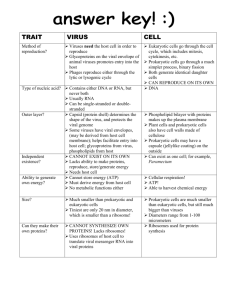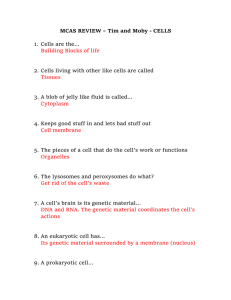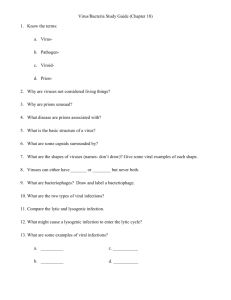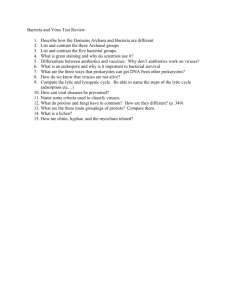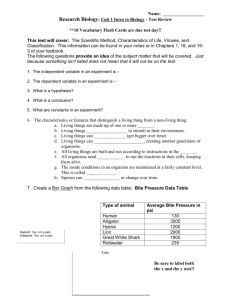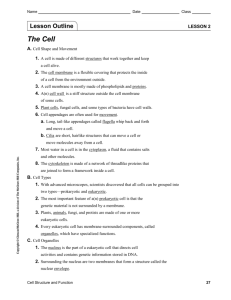Cell Type, Structure, & Function - Willimon-PHS
advertisement
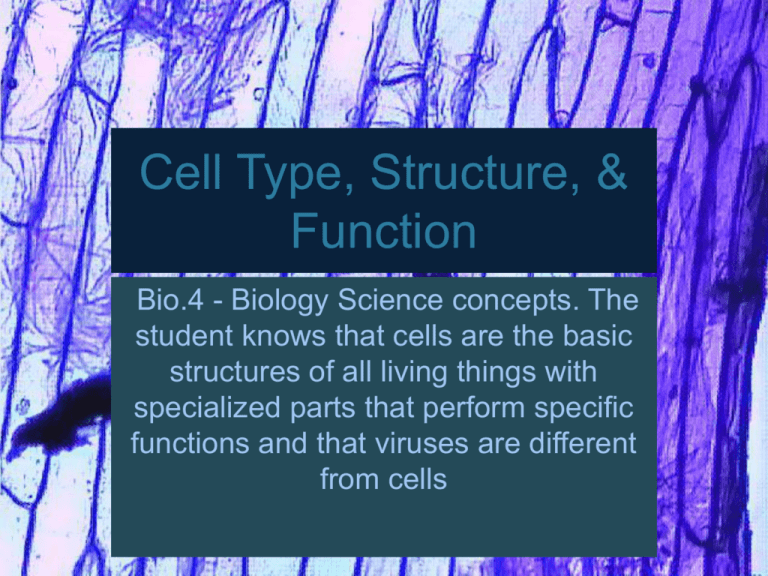
Cell Type, Structure, & Function Bio.4 - Biology Science concepts. The student knows that cells are the basic structures of all living things with specialized parts that perform specific functions and that viruses are different from cells What are the characteristics of life? Characteristics of life: •Made of cells •Use energy - metabolism •Reproduce •Respond to stimulus •Change over time - grow •Movement of materials How do we define life? Cell Theory •All living organisms are composed of cells •Cells are the smallest structures that perform the functions of life •All cells come from preexisting cells Theory •Statements that explain a phenomenon; repeatedly tested, widely accepted, and used to make predictions. What do all cells have in common? All cells have common structures Cell membrane Ribosome Cytoplasm Cells contain DNA Cells are basic unit of life Make a three column chart. (Title of slide) Two types of cells Cell History Cell size Prokaryotes Eukaryotes Prokaryotes • • Eukaryotes • • Two Cell Types Prokaryotic •“pro” – BEFORE •“karyo” – kernel, nucleus •a cell type BEFORE the evolution of a nucleus Eukaryotic •“eu” – true •“karyo” – nucleus •cell with a true nucleus Cell History Prokaryotic Eukaryotic Ancient cells Modern cells Evolved 3.5 bya Evolved 1.4 bya Billion years ago Stromatolites, ancient bacterial formations Cell Size Prokaryotic Smaller cells 1 to 10 µm Micrometer – 1/1000 of a meter Eukaryotic Larger cells 10 to 100 µm Cell Size Comparison Cell Organization Prokaryotic Simple cells with all parts in “one room” Eukaryotic Complex cells with many compartments Location of DNA Prokaryotic DNA is loose in the cytoplasm,called a nucleiod Eukaryotic DNA is protected in the nucleus Presence of Organelles Prokaryotic Ribosomes Cell membrane only Eukaryotic Many, membrane bound organelles Cell Structures and Functions Animal Cell Type of Organisms Prokaryotic Bacteria only! round Rod shaped Spiral shaped Eukaryotic Plants, Animals, Fungi, and Protists Prokaryotes: Bacteria Size of Organisms Prokaryotic Always unicellular uni = one SUPER SMALL Eukaryotic Mostly multicellular (more than one cell) Range from cell size (microscopic) to the size of a sequoia tree (83 m=272 ft) Cell Reproduction Prokaryotes Eukaryotes Viruses •Viruses are not considered living because: i. they are not made of cells and ii. need a host cell to reproduce •Viruses are much smaller than cells •Viruses and cells both contain GENETIC MATERIAL Capsid What are the functions of the viral structures? Capsid – protein shell that protects genetic information of virus What are the functions of the viral structures? Genetic information – strands of DNA or RNA used to make viral proteins inside infected host cell Viral Structure - Bacteriophage Tail – protein shaft that contracts to inject viral genetic information into host cell Viral Structure - Bacteriophage Tail fibers – proteins that attach to the outside of a host cell Viral Structure – Other Types Membranous envelope – lipids that attach and fuse to host cells membrane Viruses vs. Cellular Life Viruses • DNA or RNA as genetic information • Need a host to replicate • Never contain organelles • Do not convert energy (metabolize) Cellular Life • Only DNA as genetic information • Can reproduce independently • Eukaryotes contain organelles • Convert energy to perform tasks How do viruses reproduce? • Viruses need a host to reproduce – Goal: create more copies of their genetic material • Two methods – Lytic Cycle – Lysogenic Cycle Viral Reproduction – Lytic Cycle • Lytic Cycle – Attaches to host – Injects genetic material into host – Cellular machinery duplicates genetic material and creates viral proteins (capsids, tail fibers) – New viruses are assembled – New viruses exit the cell by bursting the cellular membrane • End result – more viruses made, cell dies Viral Reproduction – Lytic Cycle Attachment Lytic Cycle Entry Release Assembly Replication Viral Reproduction – Lysogenic Cycle • Lysogenic Cycle – – – – – Attaches to host Injects genetic material into host Viral genetic material is inserted into host genome Viral genetic material lies dormant When cell reproduces, new copies have viral genetic information – Environmental stimulus sends viral DNA into lytic cycle • End result – more viral genome made, cell lives Viral Reproduction – Lysogenic Cycle Lysogenic Cycle Attachment Entry Separation Insertion Reproduction Viral Reproduction Lytic Cycle • New viruses made • Cellular host dies Lysogenic Cycle • Genome copies made • Cellular host lives Common Viral Infections Lysogenic Cycle: – Herpes – HPV – Chicken Pox (can become shingles) – HIV – Hepatitis B Lytic: – – – – – – SARS Common Cold Influenza Rabies AIDS phase of HIV Tobacco Mosaic Virus (in plants) Viral Reproduction Lytic & Lysogenic Cycles Cell Type, Structure, & Function Bio.4 - Biology Science concepts. The student knows that cells are the basic structures of all living things with specialized parts that perform specific functions and that viruses are different from cells Cells Make Proteins Structure & Function What is structure? A structure is a physical part, or a description of how something is built. What is function? A function is a job, a purpose, or a process that needs to be done. What are organelles? An organelle is a “mini organ” inside a eukaryotic cell that carries out a specific function. Cell Membrane Lipid bilayer that surrounds the cell Embedded proteins control what materials enter and leave the cell. Cytoplasm Jelly-like fluid inside the cell membrane Supports and holds all the organelles Ribosomes Where proteins are assembled Translate genes into proteins Cell Wall Support, strength, and protection Found outside plasma membrane; made out of cellulose Plant Cell Wall Bacteria Cell Wall Flagella/Cilia Extensions of the plasma membrane that allow for movement Bacteria with many flagella Nucleus Membrane bound area where chromosomes are found Holds the DNA, or genetic information Nucleolus Dense region found in the nucleus where ribosomal RNA is made Chloroplasts Contains chlorophyll Site of photosynthesis reactions 6H2O + 6CO2 sunlight C6H12O6 + 6O2 Mitochondria Produces ATP (energy) for the cell during cellular respiration C6H12O6 + 6O2 6H2O + 6CO2 + ATP Composed of inner and outer membrane Endoplasmic Reticulum Membranous stacks with rough and smooth sections Participates in protein synthesis and membrane synthesis Golgi Apparatus Modifies and packages proteins for secretion by budding of vesicles Lysosomes Contains enzymes that break down cell wastes and foods Recycle old cell parts Lysosomes contain digestive enzymes Vacuole Stores water and pigments in plant cells Centrioles Used to organize chromosomes during cell division using spindle fibers. Cells Make Proteins Cell Type, Structure, & Function Bio.4 - Biology Science concepts. The student knows that cells are the basic structures of all living things with specialized parts that perform specific functions and that viruses are different from cells
